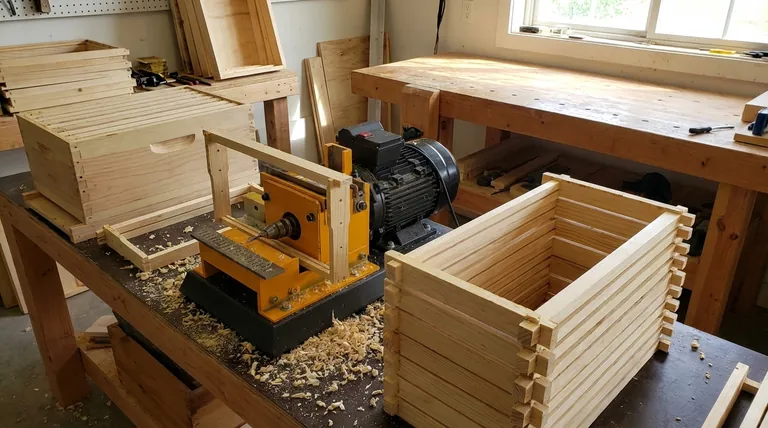At its core, a Dadant frame is a specific style of beehive frame primarily designed for use in honey supers. Its defining characteristic is its wide, straight side bars, often called "Manley style," which make the frames self-spacing and are optimized for efficient honey harvesting.
The central purpose of the Dadant-style frame is to simplify honey production. Its wide, self-spacing design maximizes honeycomb area and makes the process of uncapping honey significantly easier and faster for the beekeeper.

The Anatomy of a Dadant Frame
To understand why a beekeeper would choose this frame, we must first look at its specific design elements. Unlike the more common Hoffman-style frames, every part of a Dadant frame is geared toward honey storage.
The Defining Feature: Wide Side Bars
The most critical component is the set of Manley side bars. These vertical sections of the frame are much wider than those on a standard frame.
Typically, the entire length of the side bar is a uniform width, creating a large contact surface between adjacent frames when they are pushed together in the hive box.
The Principle of Self-Spacing
This wide-bar design makes the frames self-spacing. When placed in a honey super, you simply push them all together, and the wide bars automatically create the correct, uniform distance between each frame.
This eliminates the need for manual spacing, ensuring bees build straight, even comb that is easy to manage and harvest. This design allows the bees to draw the comb out slightly further, maximizing the amount of honey stored per frame.
Designed Specifically for Honey Supers
Dadant-style frames are almost exclusively used in the upper boxes of a hive, known as honey supers.
These boxes are dedicated to honey storage, not for the queen to lay eggs. Their design is less suited for the frequent inspections required in a brood chamber, where the queen and developing bees reside.
Understanding the Trade-offs
No piece of beekeeping equipment is perfect for every situation. The Dadant frame's specialized design comes with distinct advantages and disadvantages.
Advantage: Simplified Uncapping
This is the primary benefit. Because the side bars are straight and the comb is drawn out fully, a beekeeper can run an uncapping knife down the entire frame in one smooth motion. This dramatically speeds up the honey extraction process.
Advantage: Maximized Honeycomb
The wide spacing and lack of a "shoulder" on the side bar (common on Hoffman frames) provides a larger, unbroken surface area for honeycomb. This results in more honey per frame.
Disadvantage: Increased Propolis
The large, flat contact area between the wide side bars is a perfect place for bees to deposit propolis, a sticky resin they use as glue.
This can make the frames very difficult to separate during an inspection, requiring more force from the hive tool, which can disturb the colony.
Disadvantage: Less Versatility
These frames are a specialized tool. Their design is poorly suited for the brood chamber, where the ability to easily remove and inspect individual frames is critical for managing colony health.
Making the Right Choice for Your Apiary
Choosing a frame style depends entirely on your beekeeping goals and management practices.
- If your primary focus is high-volume, efficient honey extraction: The Dadant-style frame is an exceptional choice for your honey supers due to its ease of uncapping.
- If your primary focus is frequent brood nest inspections and ease of manipulation: You should use standard Hoffman-style frames, especially in your brood boxes.
- If you are a new beekeeper: Starting with a single, consistent frame type like the Hoffman throughout the entire hive can simplify learning and equipment management.
Ultimately, selecting the right equipment is about understanding how its design serves a specific function within the hive.
Summary Table:
| Feature | Description |
|---|---|
| Primary Use | Honey Supers (for honey storage) |
| Key Design | Wide, straight "Manley" side bars |
| Main Advantage | Self-spacing; easy, fast uncapping |
| Main Disadvantage | Increased propolis buildup; less suited for brood boxes |
| Best For | Beekeepers focused on efficient, high-volume honey production |
Ready to Boost Your Honey Production Efficiency?
As a commercial apiary or beekeeping equipment distributor, the right equipment is key to your operation's success. The specialized design of Dadant frames can significantly streamline your honey harvesting process, saving you time and maximizing yield.
At HONESTBEE, we supply high-quality beekeeping supplies and equipment, including Dadant-style frames, through our wholesale-focused operations. Let us help you equip your apiary for maximum productivity.
Contact HONESTBEE today to discuss your wholesale needs and discover how our equipment can benefit your business.
Visual Guide

Related Products
- Mini Desktop Bee Hive Frame Forming Making Machine
- Plastic Bee Frame Beekeeping Hive Frames for Wholesale
- Assembled Wooden Bee Frames with Beeswax Foundation Ready to Use by HONESTBEE
- Automatic Pneumatic Bee Frame Machine for Eyelet Insertion
- HONESTBEE Wired and Assembled Wooden Bee Frames Foundation for a Thriving Hive
People Also Ask
- What is an automatic sidebar forming machine? Automate High-Volume Beehive Frame Production
- What is the purpose of a small desktop bee frame forming machine? Automate Frame Assembly for Beekeepers
- How are Langstroth beehive frames assembled? A Step-by-Step Guide for a Durable Hive
- How does a bee frame making machine work? A Guide to Automated Metal Frame Production
- Why are Langstroth and Dadant beehive frames popular choices for honey extractors? Maximize Your Honey Yield with Standardized Equipment



















